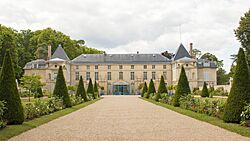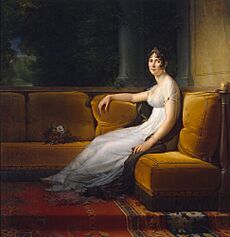Château de Malmaison facts for kids
Quick facts for kids Château de Malmaison |
|
|---|---|
 |
|
| General information | |
| Type | Château |
| Architectural style | Renaissance, Empire |
| Town or city | Rueil-Malmaison |
| Country | France |
The Château de Malmaison is a famous French château, which is a large country house or castle. It is located near the Seine river, about 15 kilometers west of Paris, France.
This beautiful home once belonged to Empress Joséphine de Beauharnais. For a short time, from 1800 to 1802, it was the center of the French government, along with the Tuileries Palace. It was also the last place Napoleon lived in France before he was sent away to an island in 1815.
Contents
A Home for an Empress and an Emperor

In 1799, Joséphine de Beauharnais bought the Malmaison mansion. Her husband, General Napoléon Bonaparte, was away in Egypt at the time. The estate was old and needed a lot of repairs. It had nearly 150 acres of woods and fields.
When Napoléon returned, he was angry that Joséphine had spent so much money on the house. It cost over 300,000 francs and needed even more money for renovations. But despite the cost, Malmaison became a happy home for them. Joséphine's daughter, Hortense de Beauharnais, called it "a delicious spot."
Joséphine's Amazing Garden
Joséphine wanted to turn the large estate into "the most beautiful and curious garden in Europe." She collected rare and exotic plants and animals from all over the world to fill her gardens.
In 1800, she built a heated building called an orangery to grow 300 pineapple plants. A few years later, she built a large greenhouse heated by a dozen stoves. Between 1803 and her death in 1814, Joséphine introduced almost 200 new plants to France for the first time.
The château became famous for its amazing rose garden. Joséphine collected about 250 different types of roses. She even hired an artist, Pierre-Joseph Redouté, to paint her beautiful roses and lilies. Prints of his paintings are still popular today.
Joséphine also loved animals. She let many different kinds of birds and animals roam freely in her garden. She had:
From Palace to Museum
After Joséphine and Napoléon divorced, she was given Malmaison to own herself. She lived there until she died in 1814. After his final defeat at the Battle of Waterloo in 1815, Napoléon stayed at Malmaison one last time before being sent to the island of Saint Helena.
Over the years, the house had different owners. In 1842, it was bought by Maria Christina, the former queen of Spain. Later, in 1861, Napoleon III (Joséphine's grandson) bought it. The château was damaged during a war in 1870.
By 1896, the estate was much smaller. A kind man named Daniel Iffla bought the château and its remaining parkland. In 1903, he gave it to the French government. A museum was opened at the château in 1905, and it was fully restored. Today, it is an important historical monument.
Visiting Malmaison Today
Today, the Château de Malmaison is a national museum that anyone can visit. You can see the rooms where Napoléon and Joséphine lived and explore the history of this special place. The museum is on the route nationale 13 (RN 13) from Paris.
Gallery
Exterior
Interior
- Assorted rooms
-
Chamber of Napoléon
- Library
- Apartment of Joséphine
-
Luxurious chamber of Joséphine de Beauharnais with her original bed.
-
The wall decoration and the furniture were restored by Napoleon III in 1865
- Dining room
See also
 In Spanish: Palacio de Malmaison para niños
In Spanish: Palacio de Malmaison para niños






















